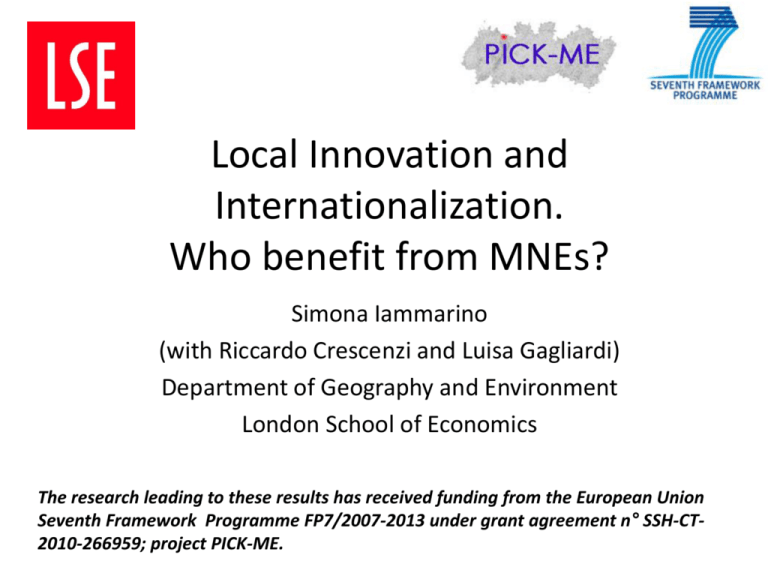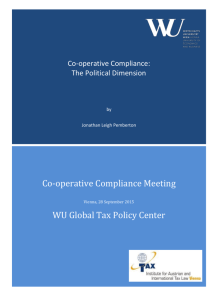No Man is an Island. Inward FDI and Local Innovative Performance.
advertisement

Local Innovation and Internationalization. Who benefit from MNEs? Simona Iammarino (with Riccardo Crescenzi and Luisa Gagliardi) Department of Geography and Environment London School of Economics The research leading to these results has received funding from the European Union Seventh Framework Programme FP7/2007-2013 under grant agreement n° SSH-CT2010-266959; project PICK-ME. Roadmap o Motivation, research question and contribution of the paper o Background literature o Data o Methodology o Results and robustness checks o Preliminary conclusions Motivation o Great emphasis has been traditionally put on the potential benefits that local firms may accrue from the presence of Multinational Enterprises (MNEs) o MNEs are expected to benefit domestic firms through positive externalities and market-mediated mechanisms; MNEs are believed to possess superior knowledge (e.g. from Cantwell, 1989, to IettoGillies, 2005/12; see also, for empirical evidence, Castellani and Zanfei, 2006; Criscuolo et al., 2010) o However, overall empirical evidence on the impacts of MNEs on local firms (in advanced economies) is mixed and inconclusive (see, for example, the reviews in Rodrik, 1999; Smeets, 2008) Research question and novel contribution of the paper Do (externalities from) MNEs foster firms’ innovative performance in recipient economies? Measurement issues: Impact of MNEs: we focus on the magnitude of financial flows rather than on the simple presence of foreign firms (as customary in the existing literature) Firms’ Performance: we focus on innovation rather than using indirect measures such as patents, TFP or labour productivity Endogeneity concerns: Novel identification strategy based on IV. Rarely done due to problems in identifying an exogenous instrument for MNEs investment activities Heterogeneous outcomes: Focus on the emergence of heterogeneous effects across different typologies of local firms Background literature o Technological and organisational advantages of MNEs over domestic firms (wide literature, from Hymer 1976/60, and Dunning, 1980, onwards) explains the generation of positive impacts on the local environment o Different types of externalities/spillovers and transmission mechanisms: Intra-industry: through demonstration (Castellani and Zanfei, 2003; Gorg and Greenaway, 2004; Crespo and Fontoura, 2007), competition (Blomstrom, 1989; Aitken and Harrison, 1999; Crespo et al., 2009); labour mobility (Fosfuri et al., 2001; Sinani and Mayer, 2004; Hale and Long, 2006) Inter-industry: through backward and forward linkages (Javorcik, 2004; Castellani and Zanfei, 2006; Blalock and Gertler, 2008; Javorcik and Sparateanu, 2008; Marcin, 2008; Bitzer et al., 2008) o Extensive literature, but mixed results (e.g. Iammarino & McCann, 2013) Data MNEs investment activities in the UK: • AFDI: Survey on foreign inward financial flows in the UK over the period 1998-2005 • ARD: Firm level database matched with AFDI following Criscuolo and Martin (2003) We recover data on the net amount of financial resources invested by foreign MNEs in the UK Inward flows are available at the 3-digits SIC level for the 1998-2005 period Data (cont.) Firms innovative performance: • CIS 2007: Firm level data on innovative performance and related activities over the period 2005-2007 The analysis is based on a broad measure of innovation in order to account also for innovation in services We refer to the definition proposed by the ONS for “Innovation Active Firms” as enterprises that fit 1 or more of the following (e.g. Cereda et al., 2005; D’Este et al., 2007, 2012; Johansson and Lööf, 2008): 1. 2. 3. Introducing new significantly improved products or processes; Engaging in innovation projects completed or ongoing; Introducing new and significantly improved forms of organisation, business structures or practices and marketing concepts or strategies. Information also on firm size, skilled employment and degree of internationalization (market of reference) Methodology o Knowledge Production Function (KPF) approach (Griliches, 1992) Innovation _ Activei,s,t = b0 + b1Inward _ Inflowss,t-T + b X + ei,s,t o Linear Probability Model (LPM): Cross sectional estimation with lagged measure of recent investment inflows o Investments linked to firms’ innovative performance by means of 3 digits SIC sector o Controls for size, skilled employment, sectoral and regional (NUTS 1) dummies Methodology (cont.) o Problems of endogeneity due to omitted variables and reverse causality o Some recent studies employ panel data techniques, controlling for time invariant omitted variables: but the bias associated with time variant omitted components and reverse causality is likely to persist o Some papers go beyond panel data techniques: Benfratello and Sembenelli (2006), Driffield (2006), and Crespo et al. (2009) adopts GMM Haskel et al. (2007) use an IV strategy instrumenting FDI in the UK with investments in the US in the same period; Ascani and Gagliardi (2013) use an IV strategy based on the “shift-share” methodology, instrumenting inward FDI with initial shares of employment by sector and territorial unit, and average amount of national FDI inflows over the period considered Methodology (cont.) o Exogeneity condition in Haskel et al. (2007): international shocks affecting MNEs strategies do not impact directly on firms’ productivity o Strong assumption (as acknowledged also by the authors): difficult to be considered a reliable hypothesis o Here, innovative identification strategy: inward investments at the 3-digits SIC in the UK instrumented by a measure of sectoral openness based on international trade flows between 1989-1990 from COMTRADE Investments are more significant in sectors characterized by a greater degree of internationalisation/openness Sectors more open to international trade in the past are more likely to be involved in the process of fragmentation of global value chains at present Descriptive Statistics Number of foreign MNEs Investment inflows (1998-2005) in the UK concentrated in services Investment flow (amount of foreign investment) Baseline results Dep.Var. Innovation Active MNEs (Investment Flows) (1) OLS (2) OLS 0.0047* (0.0028) MNEs (Number of Firms) (3) 2SLS (4) 2SLS 0.0929** (0.0444) 0.0127*** (0.0045) 0.0902** (0.0405) Skilled Employment (with uni. degree) 0.0477*** (0.0032) 0.0470*** (0.0032) 0.0453*** (0.0036) 0.0415*** (0.0043) Firm size 0.1161*** (0.0126) 0.1179*** (0.0126) 0.0969*** (0.0164) 0.1229*** (0.0131) YES YES 8813 YES YES 8813 YES YES 8813 YES YES 8813 Sectoral dummies Regional dummies Observations • The magnitude of MNEs investments is significantly and positively associated with local firms’ innovative performance; • The relation remains significant after accounting for potential endogeneity; • Results are consistent also when the regressor of interest is measured by the number of foreign firms; • This latter measure tends to overestimate the impact of MNEs activities in the OLS. Key robustness checks • First stage statistics robust to Weak Instrument Tests (Staiger and Stock, 1997, Stock and Yogo, 2005) • Coherent results when non-linear probit estimation techniques are employed • Qualitatively similar results when labour productivity is used as an alternative dependent variable Heterogeneous effects: local firms and extent of internationalization (1) Market of Reference Local National European International Dep.Var. Innovation Active (1) 2SLS (2) 2SLS (3) 2SLS (4) 2SLS 0.1043*** (0.0357) 0.0189*** (0.0037) 0.0666*** (0.0155) 0.0709** (0.0307) 0.0175*** (0.0033) 0.0225 (0.0152) 0.0323 (0.0316) 0.0204*** (0.0034) 0.0293 (0.0232) 0.0289 (0.0326) 0.0156*** (0.0057) 0.0215 (0.0238) YES YES 6485 YES YES 5059 YES YES 2403 YES YES 1611 MNEs (Investment Flows) Skilled Employment (with uni. degree) Firm size Sectoral dummies Regional dummies Observations The impact of MNE investments is significant only for domestic firms with lower degrees of internationalization: firms not engaged in the international technological contest benefit disproportionately from the presence of foreign MNEs Heterogeneous effects: local firms and extent of internationalization (2) Whether part of an MNE group YES (1) 2SLS NO (2) 2SLS 0.0121 (0.0582) 0.1738** (0.0720) Skilled Employment (with uni. degree) 0.0472*** (0.0054) 0.0417*** (0.0060) Firm size 0.0711*** (0.0159) 0.2227*** (0.0493) YES YES 4737 YES YES 4076 Dep.Var. Innovation Active MNEs (Investment Flows) Sectoral dummies Regional dummies Observations The impact of MNE investments is significant only for domestic firms with lower degrees of internationalization: firms not part of a multinational group (either UKowned or foreign-owned which invested prior to 1998) benefit disproportionately from the presence of foreign MNEs Main conclusions • Investments by MNEs are strong predictors for the innovative performance of local firms in the UK • Results are robust to endogeneity and specification tests • The evidence suggests that the positive impact is significant only for domestic firms less internationalised (in terms of both markets and ownership structure) • For these firms the presence of MNEs is a key channel of external knowledge • Further research along these lines will allow us to design more specific guidance for regional development policy Thank you for your attention! Comments are very welcome!








